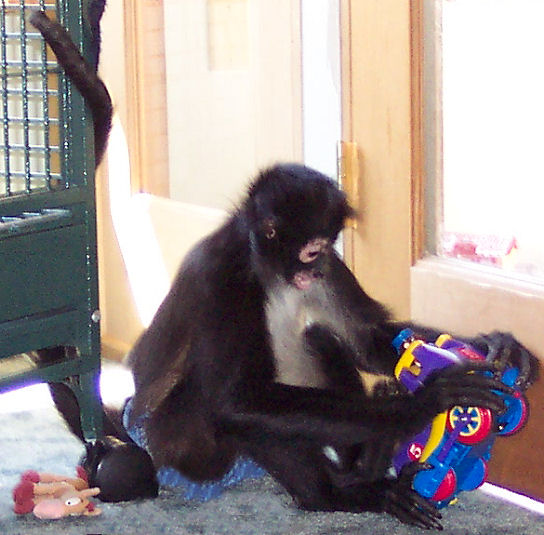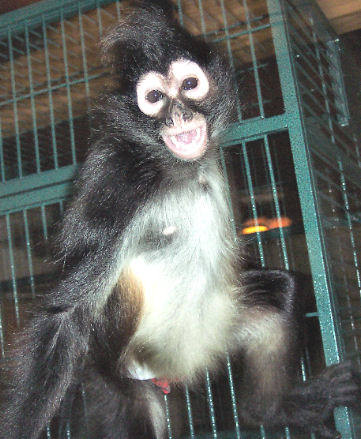















 Most Commonly Kept Primate Species in the US
TAMARINS
Most Commonly Kept Primate Species in the US
TAMARINS

Cotton Top Tamarin
***********************************
MARMOSETS
Common marmosets are small-bodied New World monkeys that are brown, grey, and yellowish in color with white ear tufts and long, banded tails. They have pale skin on their faces, which darkens with exposure to sun, and a blaze of white on their foreheads. Infants are born with a brown and yellow coat and develop the white ear tufts and forehead blaze as they age. Males and females are about the same size, with males measuring, on average, 188 mm (7.40 in) and females having an average height of 185 mm (7.28 in). Males have slightly higher average weights than females at 256 g (9.03 oz) and 236 g (8.32 oz), respectively. Members of the genus Callithrix, common marmosets have a few adaptations unique to this group and necessary for their diet and arboreal lifestyle. On all but the hallux (big toe), they have claw-like nails called tegulae instead of the characteristic flat nails (ungulae) of other primates, including humans. The presence of claw-like nails instead of true nails helps common marmosets in their squirrel-like locomotion patterns. They cling vertically to trees, run quadrupedally across branches, and move between trees by leaping. Other rare traits exhibited by callitrichines are their enlarged, chisel-shaped incisors and specialized cecum (part of the large intestine) which are adaptations for a very specialized diet. Finally, members of this group have a tendency to give birth to non-identical twins, which is unusual for primates. Common marmosets are endemic to Brazil.
Common marmosets are exudativore-insectivores and their claw-like nails, incisor morphology, and gut specialization reflect this interesting diet. Though all callitrichines feed on plant exudates, common marmosets utilize gum, sap, latex, and resin much more than other species. With lower incisors that are the same length as their canines, common marmosets systematically gnaw the bark of plants to stimulate the flow of edible exudates while vertically clinging with their claw-like nails to the trunks of trees. Once a wound to a tree has been inflicted, the monkey licks or scoops out the exudates with its teeth. Gum, sap, latex, and resin are good, non-seasonal food sources in the most extremely seasonal parts of common marmosets' range and make up a significant part of their total diet; anywhere from 20 to 70% of the time spent foraging is devoted to exudativory feeding. Exudate feeding is particularly frequent from January to April. Marmosets often revisit previously gouged holes and use holes made by other animals and natural injuries to trees to harvest gum and resin. The potential for competition between common marmosets and other frugivorous and exudativorous animals exists and some of the prime potential competitors include birds (parrots and toucans) and woolly opposums. Because plant exudate is such an abundant resource, inter- and intraspecies competition may not be important. In fact, the exudativorous behavior exhibited by common marmosets makes it possible for them to live at extremely high population densities, as high as eight animals per hectare. The other important food source for common marmosets is insect prey and they spend between 24 and 30% of their time foraging for insects. Common marmosets also include in their diet fruits, seeds, flowers, fungi, nectar, snails, lizards, tree frogs, bird eggs, nestlings, and infant mammals
The average lifespan of a wild common marmoset is 12 years (Rowe 1996).
************************************
MACAQUES
The macaques constitute a genus (Macaca) of Old World monkeys of the subfamily Cercopithecinae. Aside from humans (genus Homo), the macaques are the most widespread primate genus, ranging from northern Africa to Japan. Twenty-two macaque species are currently recognised, and they include some of the monkeys best known to non-zoologists, such as the Rhesus Macaque (as the Rhesus Monkey), Macaca mulatta, and the Barbary Macaque (as the Barbary Ape), M. sylvanus, a colony of which lives on the Rock of Gibraltar. Although several species lack tails, and their common names refer to them as apes, these are actually monkeys, with no greater relationship to the true apes than any other Old World monkeys. Several species of macaque are used extensively in animal testing. Macaque species vary in size and characteristics more so than other species of primates in the same group so I am decribing certain species in more detail below. Macaques generally live 15-20 years in captivity.
The Rhesus Macaque (Macaca mulatta), often called the Rhesus Monkey, is one of the best known species of Old World monkeys. Adult males measure approximately 53 centimeters on average and weigh an average of 7.7 kilograms. Females are smaller, averaging 47 centimeters in length and 5.3 kilograms in weight. This macaque is brown or grey in color and have pink faces which are typically bereft of fur. Its tail is of medium length and averages between 20.7 and 22.9 centimeters. It typically has a lifespan of about 25 years. The species is native to Afghanistan, northern India, Pakistan, and southern China.the Rhesus Macaque may be found in grasslands, woodlands, and in mountainous regions up to 2,500 metres in elevation. It is a good swimmer and is said to enjoy the activity.Females are mature by three years of age, and males at four. Females cycle similar to humans with menstrual cycles of around 28 days.
The typical lifespan of a rhesus monkey in captivity is approximately 15-20 years for males and 20-25 years for females. These monkeys rarely live beyond 15 years of age in the wild. A diurnal animal, the Rhesus Macaque is both arboreal and terrestrial; it is mostly herbivorous and feeds on leaves and pine needles, roots, and the occasional insect or small animal. The monkey has specialized pouch-like cheeks, allowing it to temporarily hoard its food. The gathered morsels are eaten sometime later, in safe surroundings.

Pet Macaque
*************************************
CAPUCHINS
The capuchins are the group of New World monkeys classified as genus Cebus. Their name comes from their coloration, which resembles the cowls worn by the Franciscan Capuchin order of Catholic friars. Cebus is the only genus in subfamily Cebinae.The range of the capuchin monkeys includes Central America (Honduras) and middle South America (middle Brazil, eastern Peru, Paraguay). Their body, arms, legs and tail are all darkly (black or brown) colored, while the face, throat and chest are lighter, and their head has a black cap. They reach a length of 30 to 56 cm (12 - 22 inches), with tails that are just as long as the body. They weigh up to 6 kg (13 lb, 3 oz), with brains of mass 35-40g. They are considered the most intelligent New World monkeys. Like most New World monkeys, capuchins are diurnal and arboreal. With the exception of a midday nap, they spend their entire day searching for food. At night they sleep in the trees, wedged between branches. They are undemanding regarding their habitat and can thus be found in many differing areas. Among the natural enemies of the capuchins are large falcons, cats and snakes. They are omnivores, eating not only fruits, nuts, seeds and buds, but also insects, spiders, bird eggs and small vertebrates. Capuchins live together in groups of 6 to 40 members. These groups consist of related females and their offspring, as well as several males. Usually groups are dominated by a single male, who has primary rights to mate with the females of the group, though the White-headed Capuchin groups are lead by both an alpha male and an alpha female. Mutual grooming as well as vocalization serves as communication and stabilization of the group dynamics. Females bear young every two years following a 160 to 180 day gestation. Within four years for females and eight years for males, juveniles become fully mature. In captivity, individuals have reached an age of 45 years, although life expectancy in nature is only 15 to 25 years. The Tufted Capuchin is especially noted for its long-term tool usage, one of the few examples of primate tool use other than by apes. Some organizations have been training capuchin monkeys to assist quadriplegics in a manner similar to mobility assistance dogs. After being socialized in a human home as infants, the monkeys undergo extensive training before being placed with a quadriplegic. Around the house, the monkeys help out by doing tasks including microwaving food, washing the quadriplegic's face, and opening drink bottles.

Adult female Tufted Capuchin

Clockwise: White Faced Capuchin, Marmoset, Red Handed Tamarin
***********************************
SPIDER MONKEYS
Spider monkeys are New World monkeys of the family Atelidae, subfamily Atelinae. Found in tropical forests from southern Mexico to Brazil, spider monkeys belong to the genus Ateles. The monkeys are threatened by habitat destruction through continued growth in South American agriculture. A recent comparative intelligence comparison gives spider monkeys a value a little above gorillas, so it is reasonable to believe that spider monkeys are among the most intelligent New World monkeys.
Disproportionately long, spindly limbs inspired the spider monkey's name. Their deftly prehensile tails, which may be up to 89 cm (35 inches) long, have very flexible, hairless tips and skin grooves similar to fingerprints. This adaptation to the spider monkey's strictly arboreal lifestyle serves as a fifth hand. Adults reach an average body length of 50 cm (20 inches) and a weight of 6.4 kilograms (14 pounds). The arms are very thin and very long, while the legs are shorter. When the monkey walks, its arms practically drag on the ground. The arms are not used to help with walking, unlike with most other species of monkey. The hands are also long, narrow and hook-like, and have no thumbs. The fingers are elongated and recurved.Spider monkeys are diurnal and spend the night sleeping in carefully selected trees. Groups are thought to be directed by a lead female who is responsible for planning an efficient feeding route each day. Grooming is not as important to social interaction. The diet of spider monkeys consists of about 90% fruits and nuts. Most feeding happens from dawn to 10am. Afterwards the adults rest while the young play. Through the rest of the day they may feed infrequently until around 10pm. If food is low they may eat insects, bark or rotting forest, and honey. Spider monkeys mate year-round. The female chooses a male from her group with whom to mate. Both males and females sniff their mates to check their readiness for copulation. This process is known as “anogenital sniffing”. The gestation period ranges from 226 to 232 days. Each female bears only one offspring on average, every 3-4 years.

Jimi, male spider monkey, pictured at 3 years old. Jimi was playing with his new toy.

Have any questions/comments, Send me an Email!
ALL pictures on PetMonkeyInfo.com are copywright/property of Petmonkeyinfo.com and can not be reproduced, downloaded, published or otherwise used for any purpose without prior permission.




